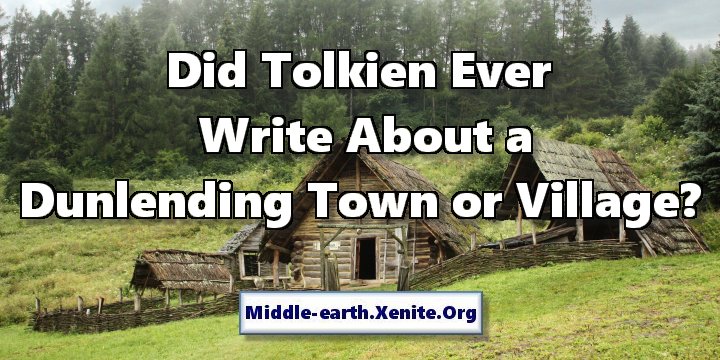
Q: Did Tolkien Ever Write About a Dunlending Town or Village?
ANSWER: As Qui-gon Jinn might have said, “Yes, Tolkien wrote about a Dunlending town — from a certain point of view.” According to The Lord of the Rings and Unfinished Tales of Númenor and Middle-earth Dunlendings seized control of Isengard in Third Age year 2710 and remained in control of the fortress until 2759 (when King Fréaláf of Rohan drove them out).
The Dunlendings did not establish Isengard (it was originally built by the Dunedain of Gondor) but they controlled it and inhabited it for several decades. That essentially made it a Dunlending fortress or town. This situation is different from when Wulf led the Dunlendings in an invasion of Rohan in 2758, by which they seized control over one or more Rohirric communities (including Edoras). The Dunlendings did not retain control over their conquests to really make the town(s) their own — they did not settle permanently as they had at Isengard.
I do not know of any other texts that mention long-term settlements of Dunlendings, although I have speculated that there were probably villages in Dunland.
Who Were the Dunlendings?
The Dunlendings were a remnant of an ancient group of peoples who settled in the lower Vales of Anduin (in lands that later became Anorien and Calenardhon, and maybe elsewhere), in Enedwaith (including Dunland) and in Eriador. Tolkien only named two ancient groups of these peoples: the Folk of Haleth (or Haladin), who entered Beleriand in the First Age and became known as the Second House of the Edain, and the Gwathuirim.
The Folk of Haleth settled in the Forest of Brethil, in northwestern Doriath, and they most lived in scattered homesteads and farms. But they built one village known as Ephel Brandir.
The Gwathuirim lived along the river Gwathló in the Second Age and they often fought with the Númenoreans – who harvested trees from the forests of Minhiriath for their ships. The Gwathuirim allied themselves with Sauron during the War of the Elves and Sauron, but after he burned down their forests they probably didn’t want to have anything more to do with him.
Toward the end of the Second Age many of the descendants of the Gwathuirim were absorbed into the people of Arnor. Of those peoples, by the end of the Third Age only the Men of Bree and the Men of Eryn Vorn remained.
In the south Gondor absorbed some of the Gwathuirim into its population. The Dead Men of Dunharrow were one such tribe, who defied Isildur’s summons to fight against Mordor. They lingered in the Ered Nimrais and may have survived in small numbers up until Baldor entered the Paths of the Dead (where he was slain, apparently by men from the same tribe).
The Dunlendings were another remnant of these peoples, and they were in part descended from men who had lived in Calenardhon. The Rohirrim drove them out after Gondor ceded that region to Eorl. Tolkien doesn’t explain why the Rohirrim and Men of Calenardhon didn’t get along but at least some of them remained in what became western Rohan until the days of Freca and Helm Hammerhand.
Conclusion
Although Tolkien doesn’t mention any towns or villages in Dunland, it seems likely that the Dunlendings could have built small settlements perhaps at most the size of the villages of the Bree-land. They were in contact with Gondor and Rohan and may also have been in contact with Tharbad until it was abandoned in Third Age Year 2912.
Fan fiction authors and gamers may want to create their own Dunlending villages. There is, however, no justification for Dunlending cities.
See also
Why Do the Men of Dunland Join Saruman?
Does Saruman Rule Dunland and the Dunlendings?
Why Didn’t Gondor Give Calenardhon to the Dunlendings?
Why Did the Rohirrim Drive the Dunlendings Out of Their Lands?
Were the Dunlendings and the Wild Men of the Hills the Same People?
# # #
Have you read our other Tolkien and Middle-earth Questions and Answers articles?
